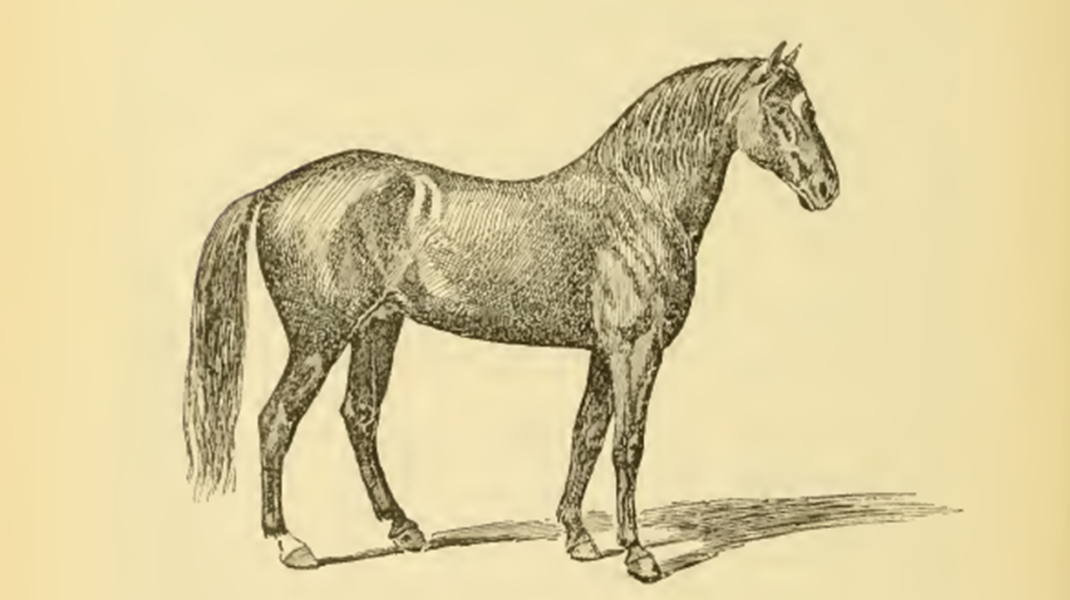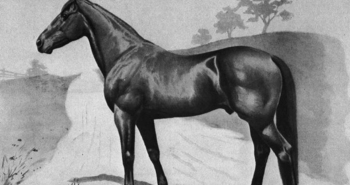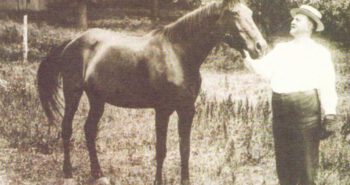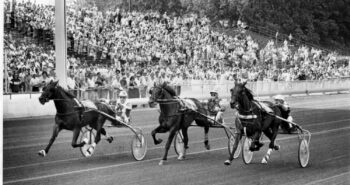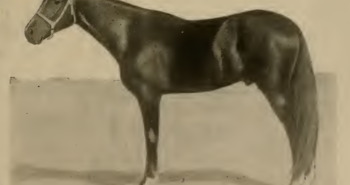He was discredited and a victim of manipulation of historical facts. As head of the family carrying his name, Henry Clay was the offer of malicious rumors, but did play a role in the development of both the American and French trotter.
In A History of Horse Racing – A Large Collection of Historical Articles on Horse Racing in England and America, published in 1869, it read that “Green’s Bashaw, foaled in 1855, and owned in Muscatine, Iowa, has some superior colts, among them Kirkwood and Bashaw Jr, both fast, and this, together with his remarkable pedigree justifies the expectations that he will become the head of a distinguished family.” What the author couldn’t know at the time was that US trotting was on the brink of complete Hambletonian dominance, but this still indicates that other horses and stallions were also held in high regard. Until Hambletonian and his sons settled the matter conclusively, a few other families had many fans – and the Clay family was one of these. (The statement that Green’s Bashaw have a “remarkable pedigree” refers to the fact that he was out of Belle, a half-sister to Hambletonian – but by Webber’s Tom Thumb, a fast horse believed to be descended from Justin Morgan on the paternal side.)
Libyan origins
The term “Clay family” hides the fact that it is really a subdivision of the “Bashaw family” so let’s go back to the start, in 1818. According to the common story, that year Richard B Jones, the American consul in Tripoli (presently capital of Libya, back then part of the Ottoman Empire) had loaned a precious Arabian stallion of his to some Danish officers but the horse was “accidentally killed” and one morning “he found in his stable a beautiful iron grey Barb”, presumably a replacement offered by these destructive Danes. They beautiful grey horse was named Grand Bashaw. Jones gifted this horse to his good friend Joseph C Morgan who sent it to the US, along with two other horses (named Grand Sultan and Saladin), through Italy and Marseille before reaching Boston and then Philadelphia.
The above story, popularized by Ken McCarr, is found almost everywhere but it is important to note that it may not be entirely true. According to The American Race-Turf register and General Stud Book by Patrick Nisbett Edgar published in 1831 – and because of the publication year it should be given more weight than newer articles – the horse, Grand Bashaw, was described as “an elegant Arabian Horse; imported from Tripoli, in August, 1820, by Mr. Joseph C. Morgan, of an iron-grey colour, foaled in 1816, full 15 hands high. He was selected by the importer from the best stock of oriental horses in that country, and (it is believed), that in point of beauty, action, and speed, he is not excelled by any horse ever imported into the United States. The horse arrived in America in 1820, and stood in Lower-Merrion township, Montgomery County near Philadelphia. No pedigree given.”
In his first season at stud, Grand Bashaw produced Young Bashaw, born 1822, another grey horse. He was bred by Thomas Logan of Montgomery County, PA and out of Pearl, a thoroughbred whose damsire was the famous Messenger – or so Logan claimed. In his book The horse of America in his derivation, history and development, published 1897, John H Wallace, who also put together the first trotting studbooks, wrote that “his dam was Pearl, by Bond’s First Consul, a famous running horse, his grandam Fancy, by imported Messenger, and his greatgrandam by imported Rockingham. This is the pedigree under which he was advertised, but it has never been authenticated in any of its crosses. Judging by the horse himself and his progeny there can hardly be a doubt that there was a Messenger cross in it, but just where cannot be determined. He made his first season in Salem, New Jersey, 1826. He was then four years old and by no means handsome or attractive in his form. His head, ear and neck were his worst features; but in addition to these defects he was flat on the ribs and habitually carried his tail to one side. His limbs and feet were as good as ever were made, but his great redeeming quality was his trotting gait. When in Salem he was only a rough, partly developed, four-year-old colt, but he showed then a step and a rate of speed so remarkable as to induce a few to breed to him, notwithstanding his ungainly appearance. He did not cover more than a dozen mares that season, and all-told he got eight foals. Out of these eight, seven proved to be superior trotters for that day.” Wallace certainly pulled no punches with his description of the horse, but this also underscores that performance breeding isn’t about looks.
A wife intervenes
The best of the seven superior trotters referenced was a black horse out of the mare Charcoal Sal, a mare said to be “just as capable at the pace or trot.” Daniel Jeffreys, a brickmaker on the Germantown road near Philadelphia, had bought Charcoal Sal in foal to Young Bashaw, and the story of the foal’s first days in life is rather peculiar. Jeffreys loved to breed, raise and train trotters and had several in his stable. Charcoal Sal was described as a very fast, coal black mare, a color the foal would inherit (and not his sire’s grey color). According to Wallace’s story, in Jeffreys’ brickyard one day in April 1827, Charcoal Sal dropped the foal and “in its weak effort to get on its feet” it managed to roll into a clay pit and into a little pond that had formed there. The foal was quickly pulled out and all members of the Jeffreys family helped to rub it dry and wrap it in warm blankets. He was weak and lacked strength in the pastern joints. One morning at the breakfast table Daniel Jeffreys told his boys he would give them a dollar if they would put the colt out of its misery and bury it out of sight, but his wife immediately countered with “the boy who would kill that colt never could eat another mouthful at that table.”
Neither Jeffreys nor his sons dared to go against the female in the house. With a lot of “womanly care and good nursing of Mrs Jeffreys”, the weak foal, named Andrew Jackson, turned into a strong and beautiful black colt. Jeffreys sold him at 5 or 6 to John Weaver, who owned him until his death on Sept 19, 1843.
A excellent trotter and his two famous foals
Andrew Jackson made his racing debut Oct 19, 1832 at the Hunting Park Course and won both two-mile heats in 6:30 and 6:23 (2.01,2 and 1.59,0 in kilometer rates) hitched to a big-wheel sulky. He only raced once or twice a year in official races and won them all. They were almost always two-mile heats and except for his first race it was to saddle. In October 1835, Andrew Jackson won in two straight heats in 5:20 and 5:19, meaning mile times of 2:40 and 2:39 1/2 (1.39,4 and 1.39,1) respectively. Andrew Jackson thus became the first stallion to go faster than 2.40, although it was commonly believed he could trot under 2:30 to saddle.
Standing stud around the Philadelphia most of his life, except two years at Long Island. In 1837, Andrew Jackson produced two spectacular foals; Long Island Black Hawk and Henry Clay. (The legend says that on the same day as racing at the Union Course in New York in 1836, Andrew Jackson bred Sally Miller and Lady Surrey, dam of the two foals, but this cannot be verified.) Long Island Black Hawk was a famous trotter and an excellent stallion who was long considered head of the “Bashaw family” of trotters.
Surrey was owned by George M. Patchen, who is Henry Clay’s breeder. Despite also descending from Grand Bashaw, Henry Clay founded a family known by his name. Henry Clay’s dam was known as simply Surrey, Old Surrey or Lady Surrey, and was said to originally hail from Surrey, New Hampshire (although one source says Surrey, Vermont, and others claim she is of Canadian origin). She’s commonly referred to as a daughter of Revenge, a son of Justin Morgan, although Wallace maintained to the bitter end that this an unverified claim that couldn’t – and shouldn’t – be given any weight. Wallace was, as is obvious, at odds with the Morgan registrars and a few others regarding Henry Clay’s maternal pedigree. However, Henry Clay and virtually all horses in the Clay family of trotters is found in both standardbred and Morgan registries (Henry Clay is #8 in the American Trotting Register and #53 in the Morgan). In Tales Of The Turf, volume 2, Gocher writes that “Surrey was very fast for her day and could trot in about 2:40, a remarkable performance in the thirties, when a 2:30 (1.33,2) horse was an unknown quantity and John Treadwell was chanting the praises of Abdallah.” Henry Clay clearly had an excellent pedigree with his sire being the first stallion below 2:40 (1.39,4) and a dam who “could trot in about 2:40.”
At 8, in 1845, Henry Clay was sold for one dollar per pound to General James Wadsworth of Livingston County, New York, who ended up paying $1,025 for the colt. The sale was brought about by Wadsworth’s admiration of Henry Clay’s son Cassius M Clay (ATR 9, also known as Cassius Marcellus Clay). According to an article in Spirit of the Times, “The magnificent trotting stallion, who carried off the grand prize at the recent National Exhibition of horses at Springfield, Mass, comes from capital stock. In size, action, beauty, Cassius M Clay has few rivals. When but two years old, we saw him led a mile, which he trotted inside of three minutes. We purchased his sire on the spot, at a very high figure, for Gen. Wadsworth of Genesee, New York. His get resemble him closely; two of them took prizes also at Springfield. American Eagle, one of them, sold at auction at the Exhibition for $1,450.” Incidentally, Cassius M Clay died the year after the National horse fair.
Ill-treated
Henry Clay showed tremendous speed and endurance for Wadsworth, who was accused of abusing the black colt. In the book Road, Track and Stable, a letter from Randolph Huntington is quoted in which he says “it is certain that for many years Henry Clay belonged to an owner who cruelly abused him. It seems to be the natural amusement of a drunken man to ill-treat a horse, and Henry Clay was one of that innumerable company of dumb beasts whose fate it has been to supply this kind of entertainment for the superior animal. When his ‘peculiar turns were upon him,’ writes one who knew both the horse and man, “W– always wanted to drive Henry Clay. At such times the city of Rochester, which is twenty-eight miles by road from Geneseo, was the objective point. When ready to return, after an experience that tries men’s nerves, he would get into the wagon, take out his whip, and, giving it a wide swing, exclaim ‘one hour and a half into my barn’, which the horse had to do. Sometimes his carriage would break down. The President of the Livingston Agricultural Society, the late ML cummings, wishing at one time to see W– on some important matters, waited for him in his barn, and W– finally drove in hanging to the dashboard, the hind axle dragging, both hind wheels gone. The horse was dripping wet, and panting so that Mr Cummings (a first-class horseman) thought that he would never recover his wind. W– took out his watch, looked at it and exclaimed ‘He did it, or I would shoot him. One hour and a half, twenty-eight miles!” On another occasion W– struck Henry Clay with a club, breaking one of his ribs, and the injury left its mark on the skeleton of the horse, which is still preserved in the National Museum at Washington.” Huntington nobly didn’t want to name Wadsworth, but Henry Clay only had one owner whose last name started with W and also only one owner who lived in Geneseo, so writing “W—” instead of his full name was not exactly being secretive.
In 1847, Mr Wadsworth had a match at mile heats, best three in five, and drove Henry Clay ninety-five miles the day before the race rather than pay forfeit. Henry Clay won, and trotted a record 2:35 (1.36,3) in one of the races. The following year the duo repeated the performance, defeating Otawa at the Buffalo course in 2:38, 2:52 and 3:03 (1.38,2, 1.46,9 and 1.53,7).
Even before he was bought by Wadsworth, Henry Clay was used as a stallion. The above-mentioned Cassius M Clay was foaled in 1843. In the same year Centerville was born. The gelding trotted 2:30 (1.33,2) in 1853, just three seconds behind the current world record. Cassius M Clay in turned sired George M Patchen in 1849. The latter beat Ethan Allen in a match race in 1860, winning in 2:25, 2:24 and 2:29 (1.30,1, 1.29,5 and 1.32,6). He later trotted 2:23 1/2 (1.29,2), then a stallion world record. Henry Clay begot trotters, and was a popular stallion. He was himself in form and disposition a near-clone of his great-grandsire Grand Bashaw, being described in Road, Track and Stable as “a coal-black horse with a beautiful white crescent on his face, very perfect, the line of it extending up and down, that is, one horn above the eyes, the other below. He had a curved neck, the fine sloping shoulders, the round swelling barrel, the small ears, the springy pasterns, the tough, round feet of a Barb or Arab horse. In his hind parts, however, he took after his dam. His hips were sharp, the rump was long and drooping. He had a great length from hip to hock, the invariable formation of a trotter, and his tail was thick and way, with a few white hairs at the dock.”
Prejudice and a ruined reputation
There was, however, a very strong prejudice in those days against the Clay blood, especially after Robert Bonner, owner of Dexter, declared that the Clay blood in a trotter was “as bad as sawdust in his oats.” Bonner, the owner of world champion Dexter, was religious and abhorred gambling, among other things, but seemed to have absolutely no qualms about speaking ill of others. The Clay horses were accused of being quitters, an accusation later also leveled against George Wilkes, one which turned out to be disproven by his sons and daughters. In American Roadsters and Trotting Horses, author HT Helm, put it in the most derogatory fashion: “the quitting tendency in some of the Clays proves it to be a deep-seated trait of character, rooted in the mental or nervous organization, and not in any lack of stamina. It is not because they can’t, but because they won’t. All such traits are deep-seated and very difficult to eradicate.” When it came to the Clay family, Helm clearly wasn’t a fan – to put it mildly.
Worse then these Bonner and Helm, however, was John Wallace, who always sunk to lows to discredit horses he, for whatever reason, didn’t like. Bingen and Henry Clay were two trotters Wallace had an issue with, and his snide remarks, selective research and false claims did much to ruin the reputation of these two stallions. In The Horse of America in his derivation, history and development, Wallace writes that “while Henry Clay remained the property of his breeder he was trained and was looked upon as a promising young horse, but I have not been able to determine what rate of speed he was able to show. He certainly did not stand anywhere near the fastest, and he does not appear to have ever won a race, and perhaps never started in one. Still, he was esteemed as one of the best horses on Long Island and was liberally supported while there.” For starters, the above-mentioned match races in 1848 was reported in both Buffalo newspapers at the time, thus Wallace’s claim is clearly misleading – and, to put it diplomatically, it would be strange if Wallace was unfamiliar with these races. Moreover, Wallace also declared in the same book, that Henry Clay ” left a numerous progeny, but as the sire of trotters he was a pronounced failure. In examining the 2:30 list I find a single one of this get, before he left Long Island, with a single heat of even 2:30.”
But what did Wallace expect, really? In 1853, the world record stood at 2:27 (1.31,4), and there were quite literally only a handful of horse who had trotted below 2:30. At the time it would make a lot more sense to look at 2:40 or 2:50 (1.39,4 or 1.46,6) trotters. That isn’t to say that Henry Clay was the leading trotting stallion of his day: he seems to have begot trotters out of all kinds of mares, yet it is hard to exactly classify him qualitatively. The Clay horses were characterized as tall, rangy horses who didn’t mature early. Yet they had real trotting ability and the blood also served to refine the coarser Messengers. This combination worked really well and is also seen in two of the five foundation stallions: Electioneer and George Wilkes.
A lasting legacy
Henry Clay was initially said to be the damsire of George Wilkes. This was later changed officially, but the facts surrounding this change are troublesome. Was Henry Clay the damsire of George Wilkes? Wallace vehemently denied this claim and used two reports from John P. Ray to convince the Board of Censors that Henry Clay could not be the damsire. Several people had a problem with this, though, and in 1912 John Day, a breeder from Waterloo, NY, dug up several sources, including the nephew of the owner of Dolly Spanker, dam of George Wilkes. When the latter came to light, though, it was ignored. Officially, therefore, George Wilkes’ maternal pedigree is unknown, but looking at the 1912 statements, there is no question that Henry Clay is in fact the damsire.
Wallace couldn’t influence the French studbook, however, and as a result it is undeniable that Henry Clay is found in the pedigree of Fuschia, often referred to as the “French Hambletonian.” The latter’s pedigree shows he is by Reynolds out of Reveuse, her by Lavater. Fuschia’s sire Reynolds is by Conquerant out of Miss Pierce, her by Succes out of Lady Pierce. The latter was a mystery for many years, but Louis Cauchois, who put together the first French trotting stud-book, uncovered that a man by the name of Pierson in New York State owned the mare Lady Pierce in 1850. It was further dug up that shge was a daughter of Henry Clay and out of a mare by Diamond. Interestingly enough, Miss Pierce, who has Henry Clay as her damsire, was the first 1.40 (2:41) trotter in France.
The Clay sireline barely lasted into the 20th century, and the last great horse from this sireline was the chestnut Stamboul 2:07 1/2 (1.19,2), born 1882. However, Henry Clay is found on the damside of several famous broodmares. In the pedigree of Beautiful Bells, by many considered the greatest broodmare in the late 1800s, he is found on both sides of the pedigree since she is 3×3 inbred on Cassius M Clay Jr, a paternal grandson of Henry Clay.
Henry Clay eventually lived out his life with Fred Fellows in Lodi, NY. In the book Road, Track and Stable, a letter from Randolph Huntington describes Henry Clay late in life; “In disposition and temper he was a very lovable horse. The last time I went to see him was in October, 1865. Henry Clay was then twenty-eight years old. Mr Fellows, who owned him, knew that I loved the old horse, and asked me if I would not like to see him out. However, not wishing to trouble him, and knowing that Henry Clay had long been blind, I answered Never Mind, but the door of his box was swung wide open, and after a cheerful “Come, Henry” from his master, the old horse sailed out into the barnyard with as lofty and sure a step as though he could see every spot in which it was possible to place a foot. Henry Clay died less than two years later, in 1867. He was 30 years old.
In 1881, the bones of Henry Clay were taken out of the ground, where they had been buried for fourteen years, mounted and set up and then presented to the Smithsonian Institute at Washington, D. C, with the following inscription:
Henry Clay
The progenitor of the entire family of Clay horses and foundation of the American trotting horse.
Presented to the National Museum by Erastus Corning, Albany, N. Y., and Henry C. Jewett, Buffalo, N. Y.
While Henry Clay deserved credit for contributing to the development of the standardbred, calling him the “foundation of the American trotting horse” was exaggerated – clearly, that honor belongs to Hambletonian. However, the efforts to discredit Henry Clay entirely were disgraceful and a historical misrepresentation.
Henry Clay
Black colt born in Brooklyn, NY in 1837. Died in Lodi, NY in 1867.
Andrew Jackson – Surrey (Revenge)
(The pedigree of Surrey is disputed)
2 starts: 2-0-0 – 2:35 / 1.36,3
Breeder: George M Patchen
Owners: George M Patchen, James Wadsworth, Kent & Bailey, Nelson Thompson, Randolph Huntington, Fred Fellows
Trainers: James Wadsworth
Drivers James Wadsworth
Groom: –

